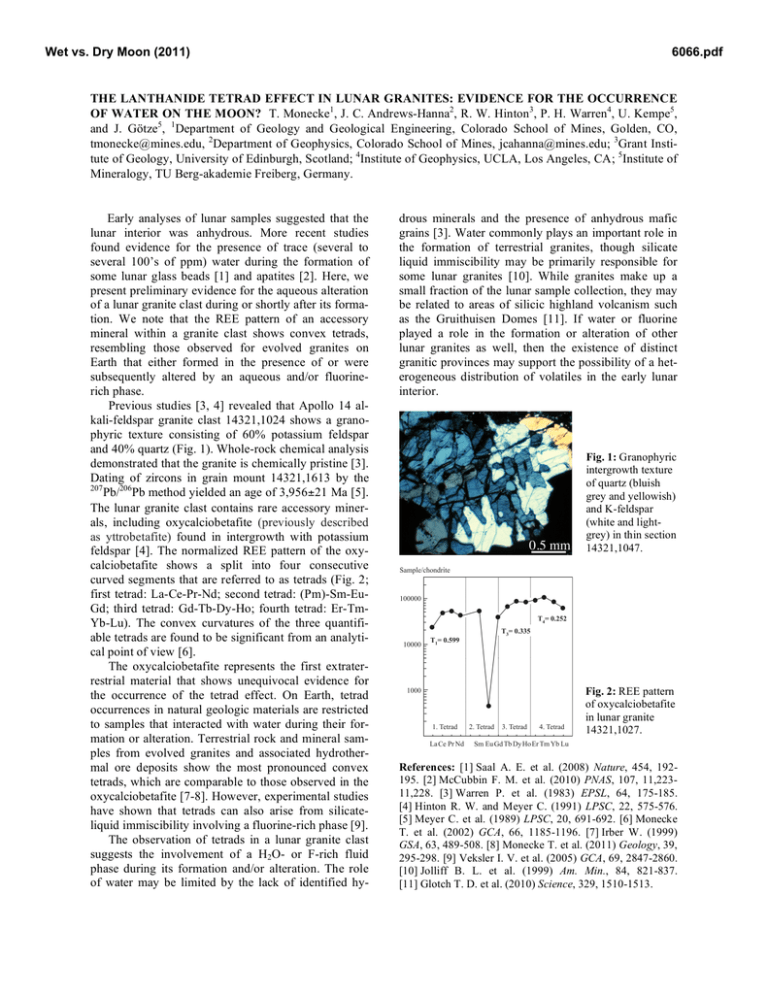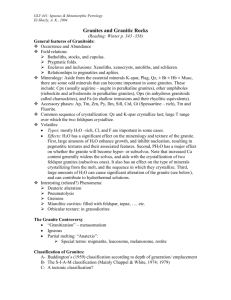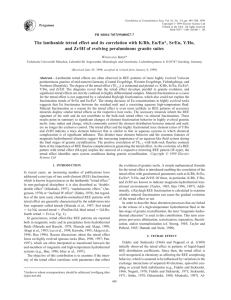THE LANTHANIDE TETRAD EFFECT IN LUNAR GRANITES: EVIDENCE FOR THE... OF WATER ON THE MOON? , J. C. Andrews-Hanna
advertisement

Wet vs. Dry Moon (2011) 6066.pdf THE LANTHANIDE TETRAD EFFECT IN LUNAR GRANITES: EVIDENCE FOR THE OCCURRENCE OF WATER ON THE MOON? T. Monecke1, J. C. Andrews-Hanna2, R. W. Hinton3, P. H. Warren4, U. Kempe5, and J. Götze5, 1Department of Geology and Geological Engineering, Colorado School of Mines, Golden, CO, tmonecke@mines.edu, 2Department of Geophysics, Colorado School of Mines, jcahanna@mines.edu; 3Grant Institute of Geology, University of Edinburgh, Scotland; 4Institute of Geophysics, UCLA, Los Angeles, CA; 5Institute of Mineralogy, TU Berg-akademie Freiberg, Germany. Early analyses of lunar samples suggested that the lunar interior was anhydrous. More recent studies found evidence for the presence of trace (several to several 100’s of ppm) water during the formation of some lunar glass beads [1] and apatites [2]. Here, we present preliminary evidence for the aqueous alteration of a lunar granite clast during or shortly after its formation. We note that the REE pattern of an accessory mineral within a granite clast shows convex tetrads, resembling those observed for evolved granites on Earth that either formed in the presence of or were subsequently altered by an aqueous and/or fluorinerich phase. Previous studies [3, 4] revealed that Apollo 14 alkali-feldspar granite clast 14321,1024 shows a granophyric texture consisting of 60% potassium feldspar and 40% quartz (Fig. 1). Whole-rock chemical analysis demonstrated that the granite is chemically pristine [3]. Dating of zircons in grain mount 14321,1613 by the 207 Pb/206Pb method yielded an age of 3,956±21 Ma [5]. The lunar granite clast contains rare accessory minerals, including oxycalciobetafite (previously described as yttrobetafite) found in intergrowth with potassium feldspar [4]. The normalized REE pattern of the oxycalciobetafite shows a split into four consecutive curved segments that are referred to as tetrads (Fig. 2; first tetrad: La-Ce-Pr-Nd; second tetrad: (Pm)-Sm-EuGd; third tetrad: Gd-Tb-Dy-Ho; fourth tetrad: Er-TmYb-Lu). The convex curvatures of the three quantifiable tetrads are found to be significant from an analytical point of view [6]. The oxycalciobetafite represents the first extraterrestrial material that shows unequivocal evidence for the occurrence of the tetrad effect. On Earth, tetrad occurrences in natural geologic materials are restricted to samples that interacted with water during their formation or alteration. Terrestrial rock and mineral samples from evolved granites and associated hydrothermal ore deposits show the most pronounced convex tetrads, which are comparable to those observed in the oxycalciobetafite [7-8]. However, experimental studies have shown that tetrads can also arise from silicateliquid immiscibility involving a fluorine-rich phase [9]. The observation of tetrads in a lunar granite clast suggests the involvement of a H2O- or F-rich fluid phase during its formation and/or alteration. The role of water may be limited by the lack of identified hy- drous minerals and the presence of anhydrous mafic grains [3]. Water commonly plays an important role in the formation of terrestrial granites, though silicate liquid immiscibility may be primarily responsible for some lunar granites [10]. While granites make up a small fraction of the lunar sample collection, they may be related to areas of silicic highland volcanism such as the Gruithuisen Domes [11]. If water or fluorine played a role in the formation or alteration of other lunar granites as well, then the existence of distinct granitic provinces may support the possibility of a heterogeneous distribution of volatiles in the early lunar interior. Fig. 1: Granophyric intergrowth texture of quartz (bluish grey and yellowish) and K-feldspar (white and lightgrey) in thin section 14321,1047. Fig. 2: REE pattern of oxycalciobetafite in lunar granite 14321,1027. References: [1] Saal A. E. et al. (2008) Nature, 454, 192195. [2] McCubbin F. M. et al. (2010) PNAS, 107, 11,22311,228. [3] Warren P. et al. (1983) EPSL, 64, 175-185. [4] Hinton R. W. and Meyer C. (1991) LPSC, 22, 575-576. [5] Meyer C. et al. (1989) LPSC, 20, 691-692. [6] Monecke T. et al. (2002) GCA, 66, 1185-1196. [7] Irber W. (1999) GSA, 63, 489-508. [8] Monecke T. et al. (2011) Geology, 39, 295-298. [9] Veksler I. V. et al. (2005) GCA, 69, 2847-2860. [10] Jolliff B. L. et al. (1999) Am. Min., 84, 821-837. [11] Glotch T. D. et al. (2010) Science, 329, 1510-1513.



